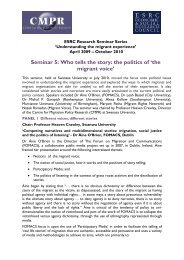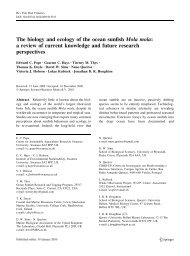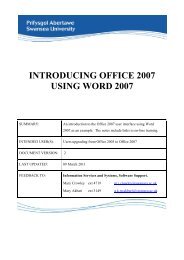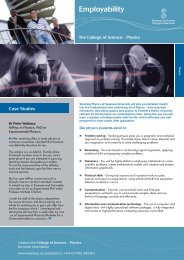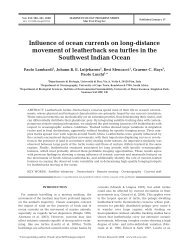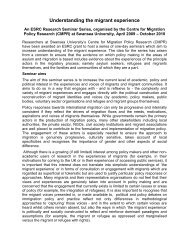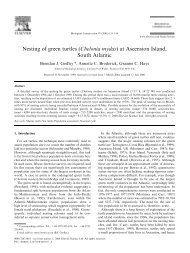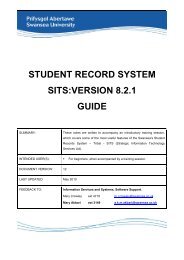The energy density of jellyfish - Swansea University
The energy density of jellyfish - Swansea University
The energy density of jellyfish - Swansea University
You also want an ePaper? Increase the reach of your titles
YUMPU automatically turns print PDFs into web optimized ePapers that Google loves.
T.K. Doyle et al. / Journal <strong>of</strong> Experimental Marine Biology and Ecology 343 (2007) 239–252<br />
243<br />
23.9 kJ g −1 for protein, 39.5 kJ g −1 for lipid and<br />
17.5 kJ g −1 for carbohydrate; see Clarke et al., 1992). All<br />
the proximate-composition data (including ash content)<br />
and subsequent <strong>energy</strong> <strong>density</strong> estimates were corrected<br />
for the effect <strong>of</strong> bound water by assuming a ‘water <strong>of</strong><br />
hydration’ <strong>of</strong> 11.7% DM (Larson, 1986; Lucas, 1994).<br />
<strong>The</strong> following equations can be used to determine revised<br />
<strong>energy</strong> densities kJ g DM −1 , assuming 11.7% water <strong>of</strong><br />
hydration. Revised GE kJ g −1 =[(proportion <strong>of</strong> protein×a)+(proportion<br />
<strong>of</strong> lipid×b)+(proportion <strong>of</strong> carbohydrate×c)]×d.<br />
Where:a=23.9 (gross <strong>energy</strong> value for<br />
protein in kJ g −1 ); b=39.5 (gross <strong>energy</strong> value for lipid in<br />
kJ g −1 ); c=17.5 (gross <strong>energy</strong> value for carbohydrate in<br />
kJ g −1 ); d=water <strong>of</strong> hydration correction factor <strong>of</strong> 1.13<br />
(i.e. water <strong>of</strong> hydration=11.7% or 0.117; therefore 1–<br />
0.117=0.883; 1/0.883=1.13). For example: if a dried<br />
<strong>jellyfish</strong> gonad sample was 27.3% DM protein, 0.58% DM<br />
lipid, and 0.94% DM carbohydrate, then the <strong>energy</strong> <strong>density</strong><br />
would be 1/0.883 [(0.273×23.9)+ (0.0058× 39.5)+<br />
(0.0094×17.5)]=7.83 kJ g DM −1 . Similarly, to correct<br />
for the dilution effect <strong>of</strong> the bound water <strong>of</strong> hydration, the<br />
<strong>energy</strong> <strong>density</strong> values from bomb-calorimetry were<br />
multiplied by 1.13.<br />
All percentage data were arcsine square root<br />
transformed prior to statistical analysis, and untransformed<br />
back to get means and S.D. in percentages.<br />
To test the difference between two slopes we used the<br />
test statistic t=(b1−b2)/(SE1 2 +SE2 2 ) 1/2 , described by<br />
Fowler et al. (1998), where b1=slope 1; b2=slope 2,<br />
SE1 =Standard error coefficient <strong>of</strong> slope 1; SE2=Standard<br />
error coefficient <strong>of</strong> slope 2.<br />
3. Results<br />
3.1. Raw results before correcting for bound water <strong>of</strong><br />
hydration<br />
3.1.1. Wet mass, DM and water content<br />
A summary <strong>of</strong> wet and dry mass (g) for each species<br />
and their tissues is found in Table 1. It took 82–410 h to<br />
dry the <strong>jellyfish</strong> samples to a constant mass, with the<br />
length <strong>of</strong> time required being largely determined by the<br />
initial wet mass <strong>of</strong> specimen and the amount <strong>of</strong> wet<br />
sample exposed to drying air (Fig. 1).<br />
Mean water contents for whole <strong>jellyfish</strong> were 95.8,<br />
96.1 and 96.2% <strong>of</strong> wet mass (C. capillata, R. octopus,<br />
and C. hysoscella respectively) (Table 2). Cyanea<br />
capillata had a significantly lower water content than<br />
the other two species (one-way ANOVA: F 2, 37 =4.75,<br />
pb0.05). <strong>The</strong>re was a significant difference between the<br />
component tissues <strong>of</strong> C. capillata, with bell tissue<br />
having higher water content than both the gonad and<br />
Fig. 1. Drying curves for C. hysoscella, C. capillata and R. octopus<br />
bell tissues. For each species separate drying curves are shown for five<br />
individuals. Mass at time zero is initial wet mass <strong>of</strong> individual<br />
analysed.



